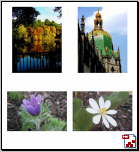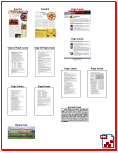
You can assemble items by stacking, unstacking and combining.
You can stack a group of PDF files into a single PDF.

Original page sizes are conserved in the stacked documents. You can stack PDF files of any flavor (image-only, searchable, normal). In general, these properties remain the same in the stack as in the source PDF files. Read-only and password-protected PDF files cannot be stacked.
Move the files to be stacked to a single folder.
Select the files in the order you want in the stack.
On the Item ribbon, click the arrow next to ![]() Combine Items
and choose
Combine Items
and choose ![]() Into
PDF Stack.
Into
PDF Stack.
— or —
Choose Stack in
the shortcut menu
You can unstack any PDF file.
![]()
It does not matter whether it was previously stacked or not. You can unstack the current page or all pages.
The result of unstacking all pages is a set of single-page files.
A multi-page file will not be kept after unstacking. A single unstacked page is removed from the stack. Unstucking current page moves the top page of the stack onto the desktop as a separate item. The unstacked files and item names take numerical suffixes.
Click the file to be unstacked.
On the Item ribbon, click the arrow next to ![]() Unstack and choose
Unstack and choose ![]() Current
Page or
Current
Page or ![]() All
Pages.
All
Pages.
— or —
Choose Unstack in the shortcut
menu and then Current Page
or All Pages.
Tip
To break a large PDF into smaller ones, unstack the large file, then select pages and stack them.
Image items, MAX or PDF files can be combined. PaperPort Professional can additionally combine text items provided that the native application that created them is installed on your computer. The target is a PDF file, typically this is a multi-page searchable PDF.
Combining usually takes more time than stacking because of PDF generation. The original items remain in their original file types.
Each original page becomes one PDF page with no resizing.

To combine items of different types into a single PDF file:
Move all the items to be combined in the same folder.
Select the items in the order you want them in the PDF file.
On the Item ribbon, click the arrow next to ![]() Combine Items and
choose
Combine Items and
choose ![]() Into PDF Stack.
Into PDF Stack.
— or —
Select Combine Items into PDF
in the shortcut menu.
This resizes the pages of the contributing items and always places four original pages onto a single PDF page. Use this to compile a photo album or to provide an overview of a set of documents.
Files combined this way cannot be unstacked.

On the Item ribbon,
click the arrow next to ![]() Combine Items,
Combine Items,
choose ![]() Into
Multi-item PDF Pages in the drop-down menu, and then
Into
Multi-item PDF Pages in the drop-down menu, and then
choose ![]() Resize to fit.
Resize to fit.
This places as many original pages onto each PDF page as it can. With full-size page, only one will fit onto a PDF page. With smaller items, you may see two, three or more original pages on a singe PDF page.
Files combined this way may not be unstacked.

On the Item ribbon:
click the arrow next to ![]() Combine Items,
Combine Items,
choose ![]() Into
Multi-item PDF Pages in the drop-down menu, and then
Into
Multi-item PDF Pages in the drop-down menu, and then
choose ![]() Maintain
original sizes.
Maintain
original sizes.
This creates thumbnails of all item pages and fits as many as possible on a PDF page. There will typically be 12 to 20 items on each PDF page. The aspect ratio of original items is conserved, but larger items are compressed more than small ones. Use this to compile index pages for photos or documents.
Files combined this way cannot be unstacked.

On the Item ribbon,
click the arrow next to ![]() Combine Items, and then
Combine Items, and then
choose ![]() Into
Thumbnail PDF Page.
Into
Thumbnail PDF Page.
Note
You can preset file names for items stacked or combined to PDF under Desktop Options > Item. The assigned name can include the current date in a range of formats or your own name which PaperPort will use for auto-naming when naming new items.